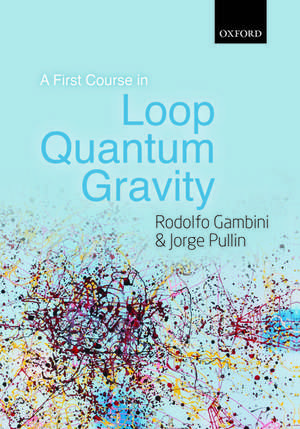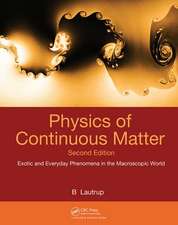A First Course in Loop Quantum Gravity
Autor Rodolfo Gambini, Jorge Pullinen Limba Engleză Hardback – 22 sep 2011
Preț: 323.13 lei
Preț vechi: 395.22 lei
-18% Nou
Puncte Express: 485
Preț estimativ în valută:
61.84€ • 63.80$ • 52.34£
61.84€ • 63.80$ • 52.34£
Carte tipărită la comandă
Livrare economică 22-28 februarie
Livrare express 28 ianuarie-01 februarie pentru 107.85 lei
Preluare comenzi: 021 569.72.76
Specificații
ISBN-13: 9780199590759
ISBN-10: 0199590753
Pagini: 192
Ilustrații: 18 b/w line figures
Dimensiuni: 180 x 241 x 19 mm
Greutate: 0.53 kg
Editura: Oxford University Press
Colecția OUP Oxford
Locul publicării:Oxford, United Kingdom
ISBN-10: 0199590753
Pagini: 192
Ilustrații: 18 b/w line figures
Dimensiuni: 180 x 241 x 19 mm
Greutate: 0.53 kg
Editura: Oxford University Press
Colecția OUP Oxford
Locul publicării:Oxford, United Kingdom
Recenzii
I highly recommend this book ... Congratulations to the authors for the great, concise, effective presentation of this challenging field to students and interested researchers coming from other fields.
Gambini and Pullin have written an excellent and truly introductory book, aimed at the undergraduate level, which fills a gap in the existing literature, and responds to the growing interest in this subject.
Loop quantum gravity is currently one of the main approaches in the search for a quantum theory of gravity. Written by well-known experts in this field, "A First Course in Loop Quantum gravity" is the first book on this topic that is accessible already to undergraduates. No previous knowledge of general relativity and quantum field theory is required; instead, the necessary material from these subjects is introduced in a clear and pedagogical way. The authors present the key features of loop quantum gravity, but also do not hide its weak points. The book can be recommended to anyone from student to established scientist who wants to get a short, reliable, and clear introduction to this fascinating field of research.
Marvellously succeeds in starting from the basics of special relativity and covering basic topics in Hamiltonian dynamics, Yang Mills theory, general relativity and quantum field theory, ending with a tour on current (loop) quantum gravity research. This is done in a short 192 pages!
Gambini and Pullin have written an excellent and truly introductory book, aimed at the undergraduate level, which fills a gap in the existing literature, and responds to the growing interest in this subject.
Loop quantum gravity is currently one of the main approaches in the search for a quantum theory of gravity. Written by well-known experts in this field, "A First Course in Loop Quantum gravity" is the first book on this topic that is accessible already to undergraduates. No previous knowledge of general relativity and quantum field theory is required; instead, the necessary material from these subjects is introduced in a clear and pedagogical way. The authors present the key features of loop quantum gravity, but also do not hide its weak points. The book can be recommended to anyone from student to established scientist who wants to get a short, reliable, and clear introduction to this fascinating field of research.
Marvellously succeeds in starting from the basics of special relativity and covering basic topics in Hamiltonian dynamics, Yang Mills theory, general relativity and quantum field theory, ending with a tour on current (loop) quantum gravity research. This is done in a short 192 pages!
Notă biografică
Rodolfo Gambini did his undergraduate work at the University of the Republic of Uruguay, went for a Ph.D. at the University of Paris and joined the faculty at the Universidad Simon Bolivar in Venezuela. He returned to Uruguay in 1997 where he has been director of several government funding agencies in addition to being a Professor at the University of the Republic. He has won the Trieste Prize in Physics, the presidential prize for scientific accomplishment in Uruguay and received an honorary doctorate from the University of the Republic.Jorge Pullin did his undergraduate work at the Instituto Balseiro in Bariloche, Argentina, did his Ph.D. thesis work at the University of Cordoba and moved as a post-doc to Syracuse University and the University of Utah. He became a faculty member at PennState and in 2001 joined the Louisiana State University as the HoraceHearne Chair in Theoretical Physics. He is the co-director of the Horace Hearne Institute of Theoretical Physics and the former co-director of the Center for Computation and Technology at the Louisiana State University. He was the chair of the Topical Group in Gravitation of the American Physical Society and served on the editorial boards of Classical and Quantum Gravity and the New Journal of Physics. He is currently on the board of Living Reviews, Papers in Physics, is managing editor of International Journal of Modern Physics D and founding editor of Physical Review X.










